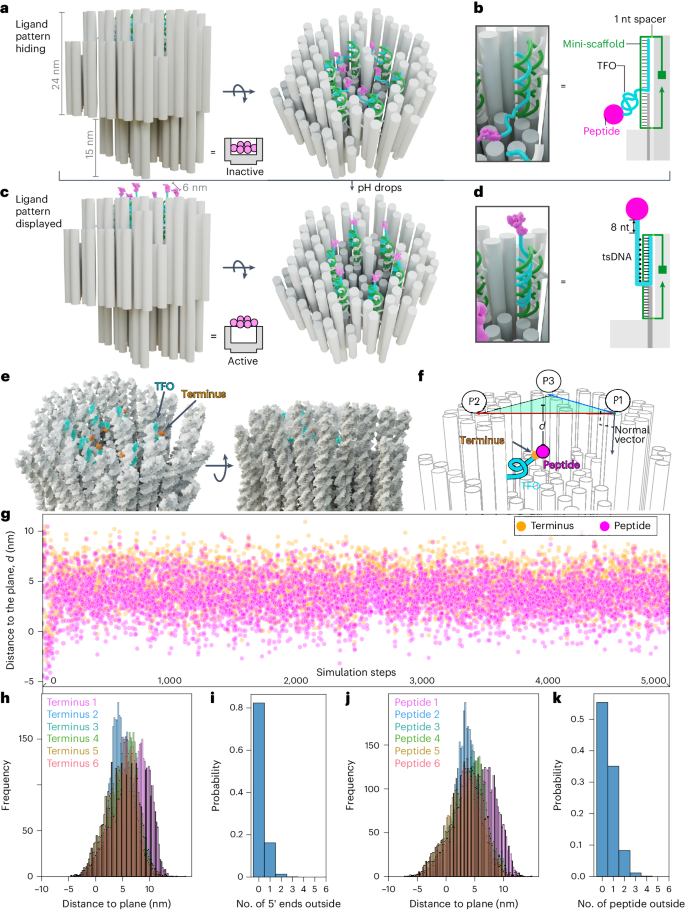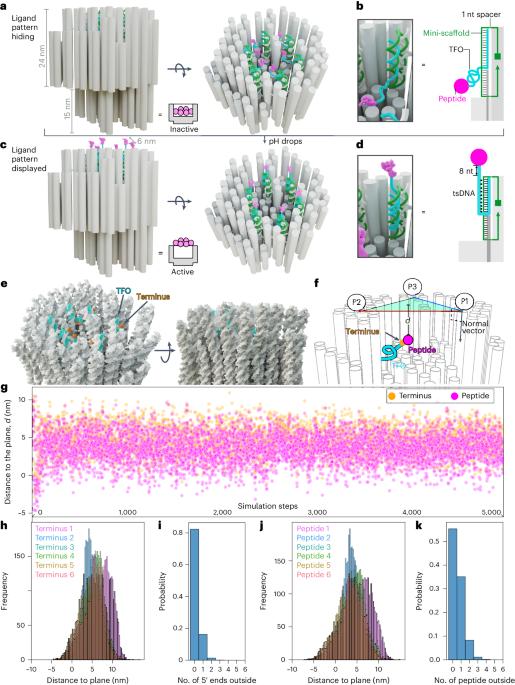可自主显示细胞毒性配体纳米图案的 DNA 机器人开关
IF 38.1
1区 材料科学
Q1 MATERIALS SCIENCE, MULTIDISCIPLINARY
引用次数: 0
摘要
死亡受体(DR)在膜上的聚集会导致细胞凋亡。为了治疗肿瘤,人们开发了启动这一机制的多价分子工具。然而,DRs 在健康组织中也普遍表达。在这里,我们展示了一种刺激响应型机器人开关纳米装置,它可以在肿瘤微环境中自主选择性地开启细胞毒性配体模式。我们展示了一种可切换的 DNA 折纸,它通常会隐藏六种配体,但一旦酸度较高,就会显示出直径为 10 纳米的六边形图案。在 pH 值为 6.5 时,它能有效地聚集 DRs 并引发人类乳腺癌细胞凋亡,而在 pH 值为 7.4 时则保持惰性。在对携带人类乳腺癌异种移植的小鼠施药时,这种纳米装置可使肿瘤生长速度降低达 70%。这些数据证明了开发配体模式开关作为靶向治疗途径的可行性和机遇。本文章由计算机程序翻译,如有差异,请以英文原文为准。


A DNA robotic switch with regulated autonomous display of cytotoxic ligand nanopatterns
The clustering of death receptors (DRs) at the membrane leads to apoptosis. With the goal of treating tumours, multivalent molecular tools that initiate this mechanism have been developed. However, DRs are also ubiquitously expressed in healthy tissue. Here we present a stimuli-responsive robotic switch nanodevice that can autonomously and selectively turn on the display of cytotoxic ligand patterns in tumour microenvironments. We demonstrate a switchable DNA origami that normally hides six ligands but displays them as a hexagonal pattern 10 nm in diameter once under higher acidity. This can effectively cluster DRs and trigger apoptosis of human breast cancer cells at pH 6.5 while remaining inert at pH 7.4. When administered to mice bearing human breast cancer xenografts, this nanodevice decreased tumour growth by up to 70%. The data demonstrate the feasibility and opportunities for developing ligand pattern switches as a path for targeted treatment. Here the authors present a pH-sensitive DNA origami nanoswitch that hides ligands for death receptors and displays them as a cytotoxic hexagonal pattern in acidic tumour microenvironments. This reduces tumour growth in a murine model of breast cancer with minimal on-target, off-tumour toxicity.
求助全文
通过发布文献求助,成功后即可免费获取论文全文。
去求助
来源期刊

Nature nanotechnology
工程技术-材料科学:综合
CiteScore
59.70
自引率
0.80%
发文量
196
审稿时长
4-8 weeks
期刊介绍:
Nature Nanotechnology is a prestigious journal that publishes high-quality papers in various areas of nanoscience and nanotechnology. The journal focuses on the design, characterization, and production of structures, devices, and systems that manipulate and control materials at atomic, molecular, and macromolecular scales. It encompasses both bottom-up and top-down approaches, as well as their combinations.
Furthermore, Nature Nanotechnology fosters the exchange of ideas among researchers from diverse disciplines such as chemistry, physics, material science, biomedical research, engineering, and more. It promotes collaboration at the forefront of this multidisciplinary field. The journal covers a wide range of topics, from fundamental research in physics, chemistry, and biology, including computational work and simulations, to the development of innovative devices and technologies for various industrial sectors such as information technology, medicine, manufacturing, high-performance materials, energy, and environmental technologies. It includes coverage of organic, inorganic, and hybrid materials.
 求助内容:
求助内容: 应助结果提醒方式:
应助结果提醒方式:


